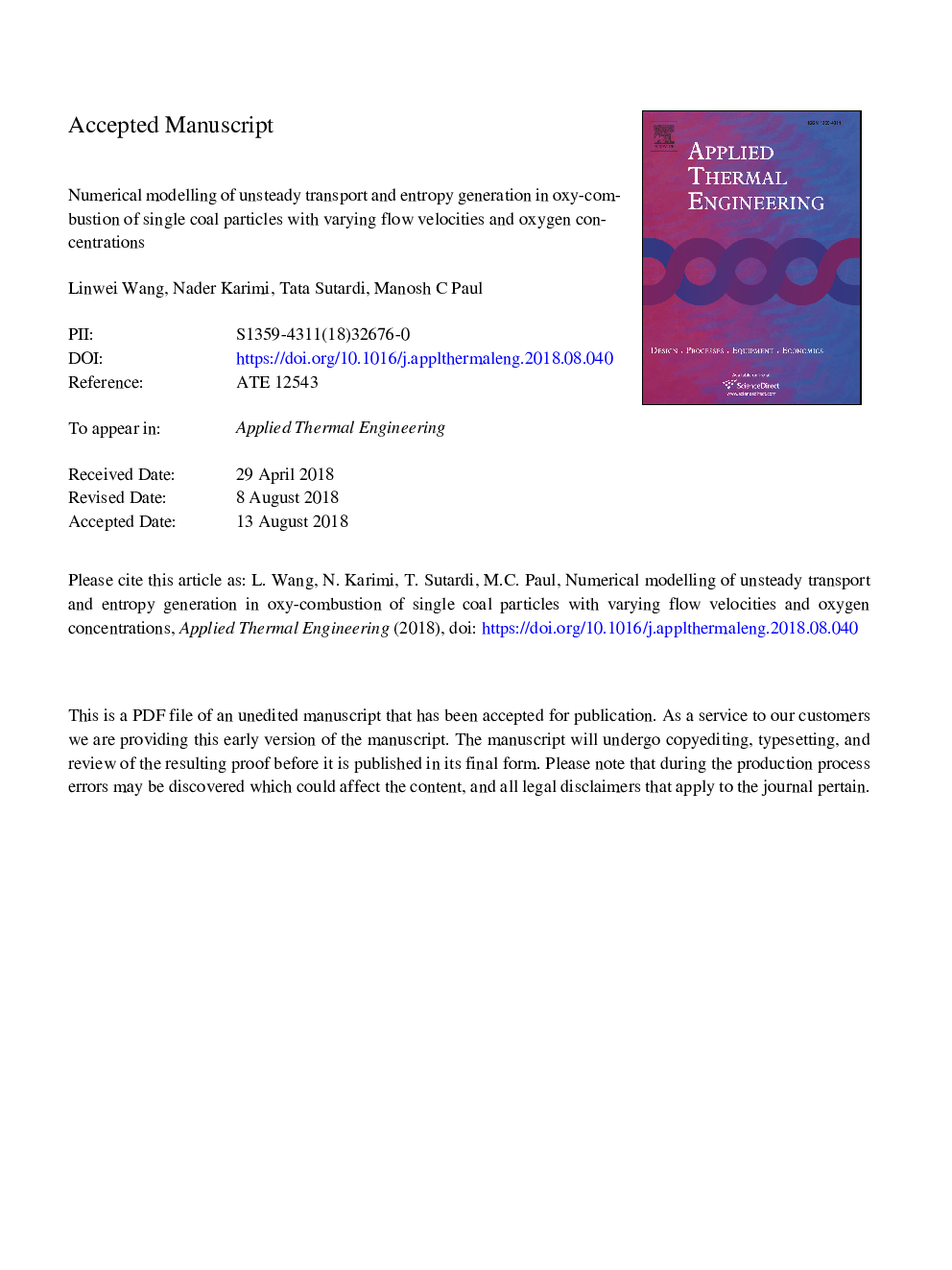| کد مقاله | کد نشریه | سال انتشار | مقاله انگلیسی | نسخه تمام متن |
|---|---|---|---|---|
| 8941924 | 1645050 | 2018 | 36 صفحه PDF | دانلود رایگان |
عنوان انگلیسی مقاله ISI
Numerical modelling of unsteady transport and entropy generation in oxy-combustion of single coal particles with varying flow velocities and oxygen concentrations
ترجمه فارسی عنوان
مدل سازی عددی انتقال بی ثبات و تولید آنتروپی در احتراق اکسین ذرات تک ذغال سنگ با سرعت جریان متفاوت و غلظت اکسیژن
دانلود مقاله + سفارش ترجمه
دانلود مقاله ISI انگلیسی
رایگان برای ایرانیان
کلمات کلیدی
انتقال گرما و جرم مداوم، نسل انتروپی ناپایدار، احتراق ذغال سنگ، تکامل اسپکتیو-زمان، اکسیژن احتراق تغییر غلظت اکسیژن،
ترجمه چکیده
نسل ناپایدار آنتروپی و انتقال گرما و مواد شیمیایی در احتراق اسیایی گذرا یک ذره ی زغال سنگ به صورت عددی مورد بررسی قرار گرفته است. فرایند سوزاندن در اتمسفر اکسیژن و نیتروژن با ترکیبات مختلف شیمیایی و تحت جریانهای خاموش یا فعال فعال می شود. شبیه سازی احتراق در برابر داده های آزمایشی موجود در یک ذره ذغال سنگ تنها در یک راکتور قطره ای تصدیق شده است. تحولات زمانی و فیزیکی دمای فاز گاز و محدوده های غالب گازهای گازی و همچنین تولید آنتروپی برای دو نوع جریان گاز مورد بررسی قرار می گیرد. نشان داده شده است که میزان تولید و حمل و نقل مواد شیمیایی در طول احتراق همگن از فرآورده ها به حداکثر خود می رسد و پس از آن تجزیه می شود. با این حال، انتقال گذرا گرمای احتراق به مدت نسبتا طولانی پس از پایان زمان زندگی ذرات ادامه می یابد. این نتیجه تولید یک مقدار زیادی از آنتروپی حرارتی در مرحله پس از احتراق است. تجزیه و تحلیل بیشتر نشان می دهد که آنتروپی تولید شده توسط واکنش های شیمیایی مهم ترین منبع عدم برگشت ناپذیر است. مهمتر از همه، نشان داده شده است که یک اکسیژن کم از جو منجر به افزایش قابل توجهی در تولید کل آنتروپی شیمیایی می شود و بنابراین به طور قابل توجهی تضعیف ناپذیری های جهانی روند می شود. با این حال، با اضافه شدن یک مولکول جزئی از اکسیژن در اتمسفر، افزودن اکسیژن تنها سبب افزایش جزئی در تولید آنتروپی می شود. این روند به طور مداوم در هر دو جریان خاموش و جریان جریان مشاهده می شود.
موضوعات مرتبط
مهندسی و علوم پایه
مهندسی شیمی
جریان سیال و فرایندهای انتقال
چکیده انگلیسی
Unsteady generation of entropy and transfer of heat and chemical species in the transient oxy-combustion of a single coal particle are investigated numerically. The burning process takes place in oxygen and nitrogen atmospheres with varying chemical compositions and under either quiescent or active flows. The combustion simulations are validated against the existing experimental data on a single coal particle burning in a drop-tube reactor. The spatio-temporal evolutions of the gas-phase temperature and major gaseous species concentration fields as well as that of entropy generation are investigated for the two types of gas flow. It is shown that the rates of production and transport of chemical species reach their maximum level during the homogenous combustion of volatiles and decay subsequently. Yet, the transient transfer of heat of combustion continues for a relatively long time after the termination of particle life time. This results in the generation of a large amount of thermal entropy at post-combustion stage. The analyses further indicate that the entropy generated by the chemical reactions is the most significant source of unsteady irreversibilities. Most importantly, it is demonstrated that a slight oxygenation of the atmosphere leads to major increases in the total chemical entropy generation and, thus it significantly intensifies the global irreversibilities of the process. However, upon exceeding a certain mole fraction of oxygen in the atmosphere, further addition of oxygen only causes minor increases in entropy generation. This trend is observed consistently in both quiescent and active flow cases.
ناشر
Database: Elsevier - ScienceDirect (ساینس دایرکت)
Journal: Applied Thermal Engineering - Volume 144, 5 November 2018, Pages 147-164
Journal: Applied Thermal Engineering - Volume 144, 5 November 2018, Pages 147-164
نویسندگان
Linwei Wang, Nader Karimi, Tata Sutardi, Manosh C. Paul,
